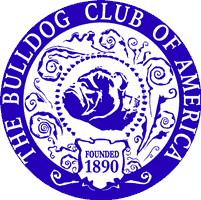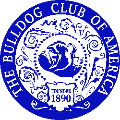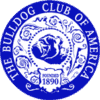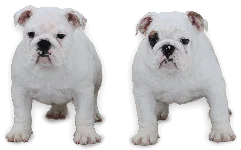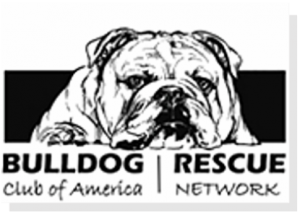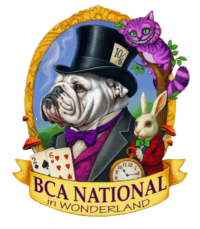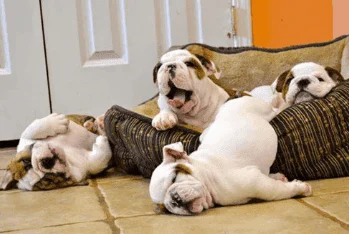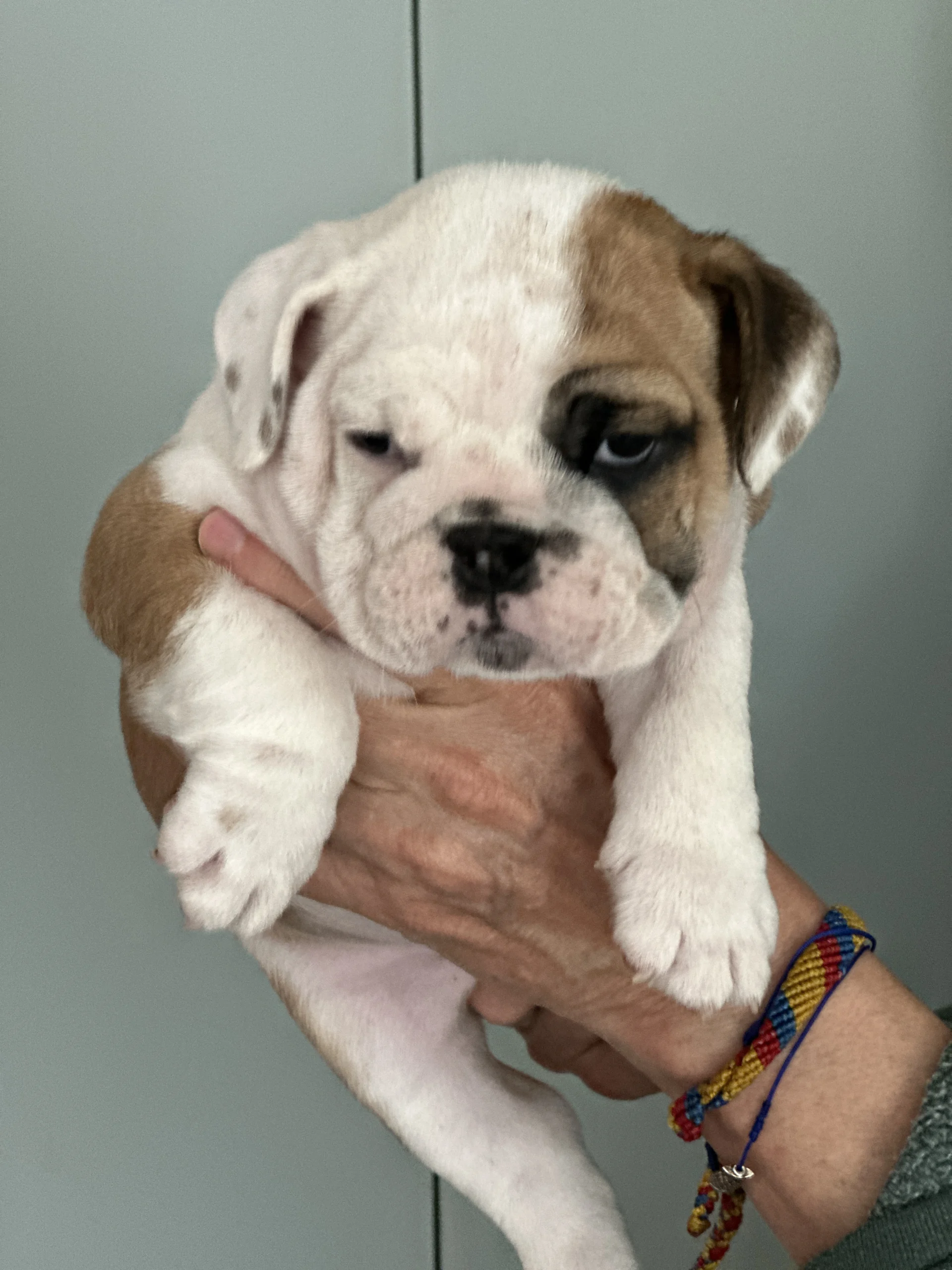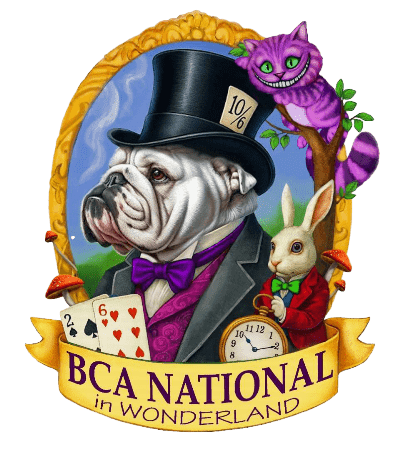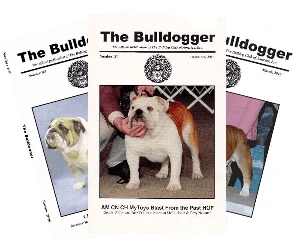In choosing a dog as a pet that you would like to show or evaluating a litter of puppies, you need to take additional steps beyond what a pet buyer would do.
First, read the Standard for Excellence for the Breed and understand what the ideal Bulldog is supposed to look like. Each breed has its own Standard against which dogs are judged.
Breeders try to improve their breeding to get dogs as close to the Bulldog Standard as possible. As you can see from looking at it, each part of the dog's anatomy and appearance is weighted in importance. About 40 percent of the score is based on the conformation of the head, about 40 percent on the rest of the dog's structure and about 20 percent on general properties of the dog. As you read the Bulldog Standard, you will realize how difficult judging the show potential of a puppy can be: weighing each of the written descriptions against a point scale for each imperfect dog present.
The disqualifications for a Bulldog in the Standard are:
- Blue or green eye(s) or parti-colored eye(s).
- Brown or liver colored nose.
- Colors or markings not defined in the standard.
- The merle pattern
Don't confuse the brown or liver colored nose with the lack of pigmentation in puppy noses. It can take some time for pigmentation to develop fully in puppies and some pink on the nose can be expected in young puppies. However, all other things being equal, the younger it's pigmented, the better.
Take the knowledge from reading the Standard to dog shows in your area to look at the dogs in the show ring and see how they compare to the Bulldog Standard. Specialties or Supported Entries, where entries are large, are especially good for this. There you can get a feel for what show dogs look like at different ages and can talk to breeders about their dogs. Most of us are very approachable, especially if you want to know about our dogs and are interested in owning a show puppy.
You should learn at least a little about the breeding lines in the area and what characteristics are predominant in each. Since no Bulldog matches the Standard, you will find that different breeders produce slightly different looks in their dogs. They each approach the Bulldog Standard, but in different ways. You may find one type more appealing to you than another. Finally, you should learn to read a pedigree, understanding the use of line breeding and out-crosses.
Don't assume a dog in the pedigree that is not a Champion is not a quality dog. Breeders have miscounted points and thought a dog was finished when it wasn't; a dog imported into the U.S. may be too old to become a Champion here; English Championships are harder to obtain for lines that go back to English forbearers; an otherwise sound dog may become injured, preventing his finishing his Championship or a beautiful specimen may be in a pet home and never get shown. These are some of the reasons you must get to know your potential show dog's pedigree.
When choosing a dog or bitch, you should also find out which dogs and bitches in the pedigree are "top producers," that is, those dogs which have sired at least 10 champions and bitches which have produced at least four champions. It would also be good to know if any have won the Beckett Award (the dog and bitch producing the most Champions in a five-year period). Few dogs win these awards and the more the pedigree contains, the more likely (other things being equal) that your dog will be a good stud or brood bitch. It is a more useful judge of the quality of the produce from bitches since they produce fewer offspring than a dog can. A dog with a large number of prodigy may have sired more champions, but unless you look at the percentage of champions (an almost impossible number to find), you won't know the quality of their average offspring.
Once you have zeroed in on a line or lines you are interested in, contact the breeders. Most breeders keep lists of people interested in their future breedings and will contact you when they have a puppy available.
You also need to think about whether you want a dog or a bitch. While most breeders sell dogs outright, many will only sell a bitch on "breeders’ terms" to a beginner - meaning a cash price plus the choice of the stud and the return of one or more puppies from the first litter bred. Some breeders have variable cash prices for bitches depending on the number of puppies they get back.
The personality of the dog or bitch is more important than its sex in determining how it will behave and whether it will fit your needs. Dogs are naturally pack animals and there will always need to be a pack leader. You need to be sure it is you and not the dog.
Both males and females can be dominant or submissive. Although males will frequently be dominant over a female, that is not always the case and you should assess the dog's personality, especially if you have other dogs in the household, to see how they will fit in. Since some aspects of personality are passed on to offspring, either through genetics or early nurturing, the personalities of the sire and dam can be important in making your choice of a puppy.
As you look for a 2-4 month old show prospect, you should look for some specific traits - all derived from the Breed Standard. Of course, you won't find them all in any one dog, but the better the dog is in these areas, the more likely he or she can be a Champion. Besides the factors considered in choosing a pet, you should see:
- a relatively square, large head (some dome exists in most young puppies, with more in some lines than in others) with the start of a good layback (not too nosey)
- a good width of jaw with a turn-up of jaw and a slightly undershot jaw (depending on the age, the jaw may be slightly overshot, but not too much, since the jaw will continue to come forward as the puppy matures)
- dark eyes set far apart
- small, thin, well-set ears
- a short nose and wide nostrils
- a short, cobby body (a short dog can get long, but a long one won't shorten) with good bone compared with size (bone generally will not get heavier, but can get lighter)
- good width between the front legs and not leggy (not too much space under the chest and brisket when looking from the front)
- a low tail set (the carriage may change, but not the set), with the end not going below the hock with good rear legs (not bowed or too cow hocked). In addition, a dog's testicles should be descended so they can both be felt upon examination. While some in and out slippage may be apparent in some lines until a later age, especially when under stress, you should be able to find both of them. Since you should not breed and, under AKC rules, cannot show a dog that does not have both testicles, be sure they are there before purchasing a show prospect. A retained testicle could also cause health problems and many veterinarians recommend neutering a dog with a retained testicle.
